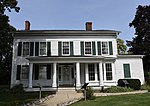Kellogg Community College
1956 establishments in MichiganAlbion, MichiganBattle Creek, MichiganBuildings and structures in Branch County, MichiganBuildings and structures in Calhoun County, Michigan ... and 12 more
Coldwater, MichiganCommunity colleges in MichiganEducation in Branch County, MichiganEducation in Calhoun County, MichiganHastings, MichiganMichigan Community College Athletic AssociationMichigan school stubsMidwestern United States university stubsNJCAA athleticsTwo-year colleges in the United StatesUniversities and colleges established in 1956Use mdy dates from May 2018

Kellogg Community College (KCC) is a public community college based in Battle Creek, Michigan, with sites in Battle Creek, Albion, Coldwater, Hastings and in the Fort Custer Industrial Park. It serves approximately 8,400 students annually via five campuses, customized training, and online coursework. The KCC service district covers Barry, Branch and Calhoun counties in south central Michigan. The tax district includes most of Calhoun County and small portions of Barry, Branch, Hillsdale, Kalamazoo and St. Joseph counties. KCC, a nonprofit institution, is governed by a publicly elected Board of Trustees, which sets policy and budgeting priorities.
Excerpt from the Wikipedia article Kellogg Community College (License: CC BY-SA 3.0, Authors, Images).Kellogg Community College
Battle Creek Linear Park, Battle Creek
Geographical coordinates (GPS) Address Nearby Places Show on map
Geographical coordinates (GPS)
| Latitude | Longitude |
|---|---|
| N 42.3349 ° | E -85.1772 ° |
Address
Kellogg Community College
Battle Creek Linear Park
49016 Battle Creek
Michigan, United States
Open on Google Maps








